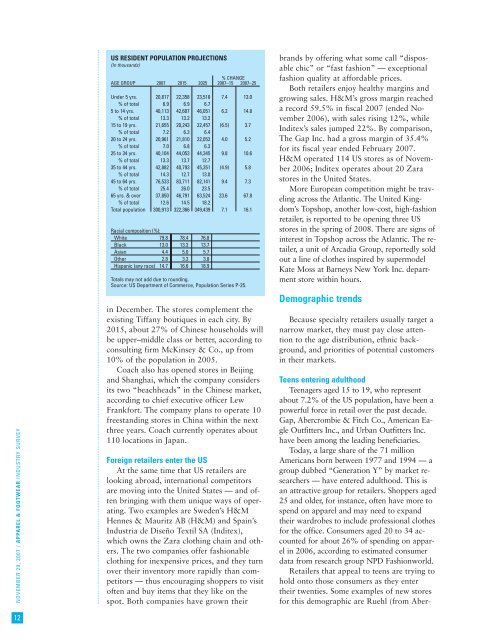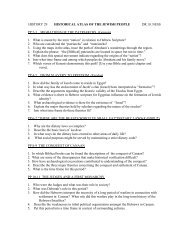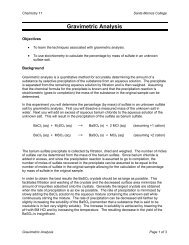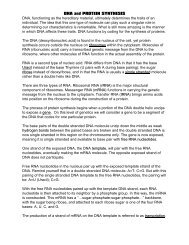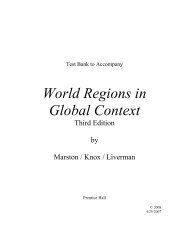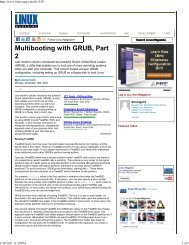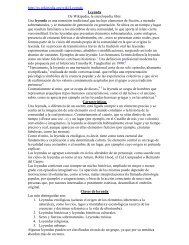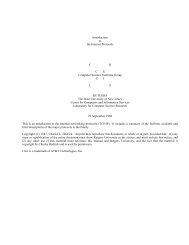Create successful ePaper yourself
Turn your PDF publications into a flip-book with our unique Google optimized e-Paper software.
NOVEMBER 29, 2007 / APPAREL & FOOTWEAR INDUSTRY SURVEY<br />
12<br />
US RESIDENT POPULATION PROJECTIONS<br />
(In thousands)<br />
% CHANGE<br />
AGE GROUP 2007 2015 2025 2007–15 2007–25<br />
Under 5 yrs. 20,817 22,358 23,518 7.4 13.0<br />
% of total 6.9 6.9 6.7<br />
5 to 14 yrs. 40,113 42,607 46,051 6.2 14.8<br />
% of total 13.3 13.2 13.2<br />
15 to 19 yrs. 21,655 20,243 22,457 (6.5) 3.7<br />
% of total 7.2 6.3 6.4<br />
20 to 24 yrs. 20,961 21,810 22,052 4.0 5.2<br />
% of total 7.0 6.8 6.3<br />
25 to 34 yrs. 40,104 44,053 44,345 9.8 10.6<br />
% of total 13.3 13.7 12.7<br />
35 to 44 yrs. 42,882 40,793 45,351 (4.9) 5.8<br />
% of total 14.3 12.7 13.0<br />
45 to 64 yrs. 76,533 83,711 82,141 9.4 7.3<br />
% of total 25.4 26.0 23.5<br />
65 yrs. & over 37,850 46,791 63,524 23.6 67.8<br />
% of total 12.6 14.5 18.2<br />
Total population 300,913 322,366 349,439 7.1 16.1<br />
Racial composition (%):<br />
White 79.8 78.4 76.8<br />
Black 13.0 13.3 13.7<br />
Asian 4.4 5.0 5.7<br />
Other 2.8 3.3 3.8<br />
Hispanic (any race) 14.7 16.6 18.9<br />
Totals may not add due to rounding.<br />
Source: US Department of Commerce, Population Series P-25.<br />
in December. The stores complement the<br />
existing Tiffany boutiques in each city. By<br />
2015, about 27% of Chinese households will<br />
be upper–middle class or better, according to<br />
consulting firm McKinsey & Co., up from<br />
10% of the population in 2005.<br />
Coach also has opened stores in Beijing<br />
and Shanghai, which the company considers<br />
its two “beachheads” in the Chinese market,<br />
according to chief executive officer Lew<br />
Frankfort. The company plans to operate 10<br />
freestanding stores in China within the next<br />
three years. Coach currently operates about<br />
110 locations in Japan.<br />
Foreign retailers enter the US<br />
At the same time that US retailers are<br />
looking abroad, international competitors<br />
are moving into the United States — and often<br />
bringing with them unique ways of operating.<br />
Two examples are Sweden’s H&M<br />
Hennes & Mauritz AB (H&M) and Spain’s<br />
Industria de Diseño Textil SA (Inditex),<br />
which owns the Zara clothing chain and others.<br />
The two companies offer fashionable<br />
clothing for inexpensive prices, and they turn<br />
over their inventory more rapidly than competitors<br />
— thus encouraging shoppers to visit<br />
often and buy items that they like on the<br />
spot. Both companies have grown their<br />
brands by offering what some call “disposable<br />
chic” or “fast fashion” — exceptional<br />
fashion quality at affordable prices.<br />
Both retailers enjoy healthy margins and<br />
growing sales. H&M’s gross margin reached<br />
a record 59.5% in fiscal 2007 (ended November<br />
2006), with sales rising 12%, while<br />
Inditex’s sales jumped 22%. By comparison,<br />
The Gap Inc. had a gross margin of 35.4%<br />
for its fiscal year ended February 2007.<br />
H&M operated 114 US stores as of November<br />
2006; Inditex operates about 20 Zara<br />
stores in the United States.<br />
More European competition might be traveling<br />
across the Atlantic. The United Kingdom’s<br />
Topshop, another low-cost, high-fashion<br />
retailer, is reported to be opening three US<br />
stores in the spring of 2008. There are signs of<br />
interest in Topshop across the Atlantic. The retailer,<br />
a unit of Arcadia Group, reportedly sold<br />
out a line of clothes inspired by supermodel<br />
Kate Moss at Barneys New York Inc. department<br />
store within hours.<br />
Demographic trends<br />
Because specialty retailers usually target a<br />
narrow market, they must pay close attention<br />
to the age distribution, ethnic background,<br />
and priorities of potential customers<br />
in their markets.<br />
Teens entering adulthood<br />
Teenagers aged 15 to 19, who represent<br />
about 7.2% of the US population, have been a<br />
powerful force in retail over the past decade.<br />
Gap, Abercrombie & Fitch Co., American Eagle<br />
Outfitters Inc., and Urban Outfitters Inc.<br />
have been among the leading beneficiaries.<br />
Today, a large share of the 71 million<br />
Americans born between 1977 and 1994 — a<br />
group dubbed “Generation Y” by market researchers<br />
— have entered adulthood. This is<br />
an attractive group for retailers. Shoppers aged<br />
25 and older, for instance, often have more to<br />
spend on apparel and may need to expand<br />
their wardrobes to include professional clothes<br />
for the office. Consumers aged 20 to 34 accounted<br />
for about 26% of spending on apparel<br />
in 2006, according to estimated consumer<br />
data from research group NPD Fashionworld.<br />
Retailers that appeal to teens are trying to<br />
hold onto those consumers as they enter<br />
their twenties. Some examples of new stores<br />
for this demographic are Ruehl (from Aber-


